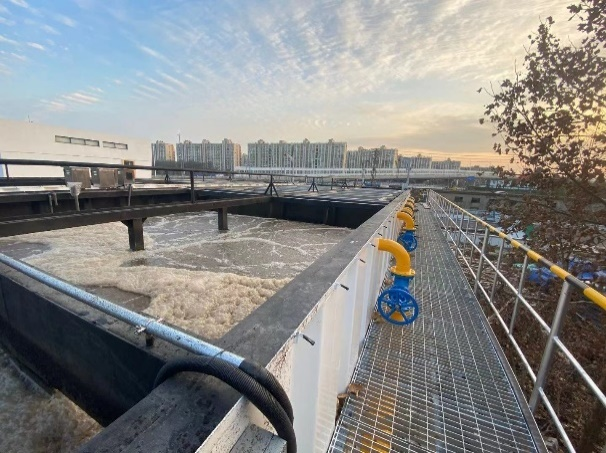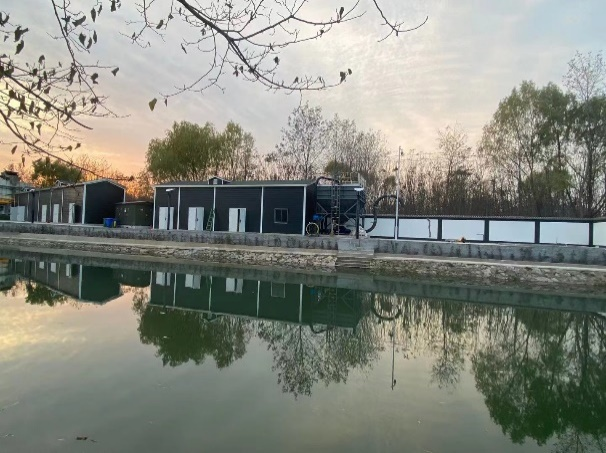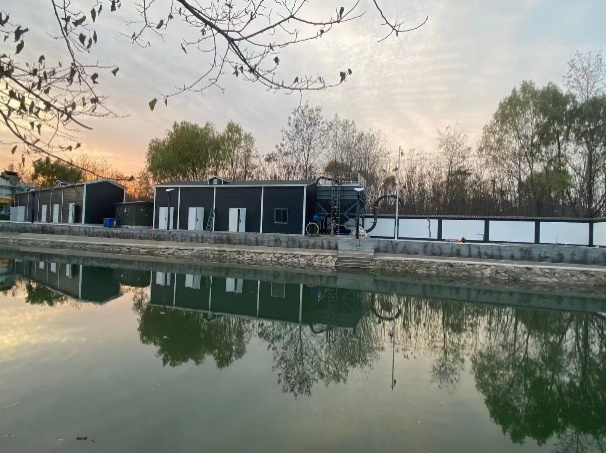MBR is a wastewater treatment process integrating biochemical treatment and membrane filtration treatment, which has the technical characteristics of stable, controllable and good effluent quality. During the operation of the process, most of the pollutants can be removed in the biochemical treatment unit. The MF or UF membrane filtration process mainly ensures the effluent quality from three aspects:
1) Completely intercepting the suspended solids in the sludge mixture.
2) The sludge retention time (SRT) and hydraulic retention time (HRT) are completely separated; The sludge concentration of each process unit is improved, the sludge load is reduced, and the degradation of pollutants by microorganisms is further enhanced.
3) Enriched nitrifying bacteria to enhance ammonia removal; Combined with the utilization of carbon source in high concentration sludge, the removal of total nitrogen could be further enhanced.

MBR system usually includes membrane tank and front-end biochemical treatment unit. The common process aiming at nitrogen and phosphorus removal of municipal sewage includes "anaerobic tank + anoxic tank + aerobic tank + membrane tank (A/A/O-MBR, contains the derivative of A/A/O process) ", "anaerobic tank + anoxic tank + aerobic tank + anoxic tank + membrane tank (A/A/O/A-MBR)", etc.
The effluent quality of the MBR with long-term stable operation (partially assisted phosphorus removal by chemicals) can reach the GB 18918-2002 Grade A Discharge Standard stably, and the overall pollutant removal rate is better than that of the traditional activated sludge method. Membrane separation combined with optimization of biological units, such as enhanced endogenous denitrification of the A/A/O/A-MBR process, effluent can meet more stringent local discharge standards, Such as DB 32/1072 -- 2018 Jiangsu Province local standard [ρ(COD) ≤40 mg /L, ρ(NH+ 4-N) ≤3 mg /L, ρ(TN) ≤10 mg /L, ρ(TP) ≤0.3 mg /L].
With the promotion of water-saving concepts and policies, recycled water reuse applications show a diversified trend, and a variety of reuse applications require high-quality recycled water. For example, when it is used for groundwater recharge, it should meet the concentration requirements of heavy metals and other toxic and harmful substances in GB /T 19772 -- 2005 Groundwater Recharge Water Quality for Municipal Sewage Regeneration, and when it is used for boiler recharge water, it should meet the water quality indicators of GB /T 19923 -- 2005 Industrial Water Quality for Municipal Sewage Regeneration and Utilization, and carry out softening and desalting treatment according to boiler operating conditions. In this case, MBR effluent needs further in-depth treatment, and the stable and excellent effluent quality of MBR also provides a guarantee for the stable operation of subsequent in-depth treatment (such as NF and RO).

MBR is a wastewater treatment process integrating biochemical treatment and membrane filtration treatment, which has the technical characteristics of stable, controllable and good effluent quality. During the operation of the process, most of the pollutants can be removed in the biochemical treatment unit. The MF or UF membrane filtration process mainly ensures the effluent quality from three aspects:
1) Completely intercepting the suspended solids in the sludge mixture.
2) The sludge retention time (SRT) and hydraulic retention time (HRT) are completely separated; The sludge concentration of each process unit is improved, the sludge load is reduced, and the degradation of pollutants by microorganisms is further enhanced.
3) Enriched nitrifying bacteria to enhance ammonia removal; Combined with the utilization of carbon source in high concentration sludge, the removal of total nitrogen could be further enhanced.

MBR system usually includes membrane tank and front-end biochemical treatment unit. The common process aiming at nitrogen and phosphorus removal of municipal sewage includes "anaerobic tank + anoxic tank + aerobic tank + membrane tank (A/A/O-MBR, contains the derivative of A/A/O process) ", "anaerobic tank + anoxic tank + aerobic tank + anoxic tank + membrane tank (A/A/O/A-MBR)", etc.
The effluent quality of the MBR with long-term stable operation (partially assisted phosphorus removal by chemicals) can reach the GB 18918-2002 Grade A Discharge Standard stably, and the overall pollutant removal rate is better than that of the traditional activated sludge method. Membrane separation combined with optimization of biological units, such as enhanced endogenous denitrification of the A/A/O/A-MBR process, effluent can meet more stringent local discharge standards, Such as DB 32/1072 -- 2018 Jiangsu Province local standard [ρ(COD) ≤40 mg /L, ρ(NH+ 4-N) ≤3 mg /L, ρ(TN) ≤10 mg /L, ρ(TP) ≤0.3 mg /L].
With the promotion of water-saving concepts and policies, recycled water reuse applications show a diversified trend, and a variety of reuse applications require high-quality recycled water. For example, when it is used for groundwater recharge, it should meet the concentration requirements of heavy metals and other toxic and harmful substances in GB /T 19772 -- 2005 Groundwater Recharge Water Quality for Municipal Sewage Regeneration, and when it is used for boiler recharge water, it should meet the water quality indicators of GB /T 19923 -- 2005 Industrial Water Quality for Municipal Sewage Regeneration and Utilization, and carry out softening and desalting treatment according to boiler operating conditions. In this case, MBR effluent needs further in-depth treatment, and the stable and excellent effluent quality of MBR also provides a guarantee for the stable operation of subsequent in-depth treatment (such as NF and RO).
